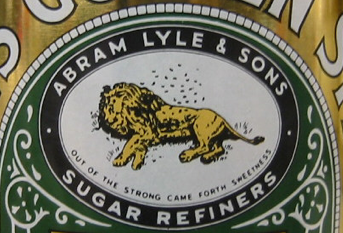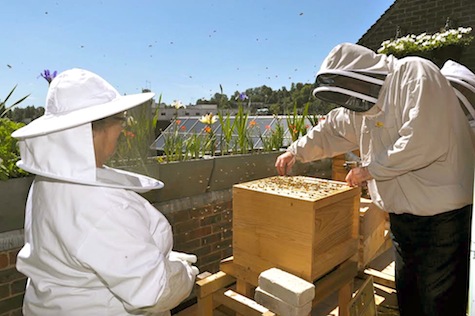 Abraham Lincoln
If given the truth, the people can be depended upon to meet any national crisis...
Abraham Lincoln
If given the truth, the people can be depended upon to meet any national crisis...
 Guildford news...
for Guildford people, brought to you by Guildford reporters - Guildford's own news service
Guildford news...
for Guildford people, brought to you by Guildford reporters - Guildford's own news service
Town Centre Bee Keeping – Honey From an Unlikely Guildford Rooftop
Published on: 23 Nov, 2013
Updated on: 27 Nov, 2013
By Luke Insoll
 Everyday hundreds of busy shoppers pass through White Lion Walk, off Guildford High Street, unaware that just 50 feet or so above them is the unlikely home of up to half a million English honeybees.
Everyday hundreds of busy shoppers pass through White Lion Walk, off Guildford High Street, unaware that just 50 feet or so above them is the unlikely home of up to half a million English honeybees.
Since September 2010, the popular shopping centre has maintained several hives on its rooftop and now sells the honey to shoppers intrigued by the thought of tasting a very local product.
Steve Cotney, centre manager and the man behind the apiary, said: “Some people keep bees for the honey. We keep bees for the bees.
“The focus of this project is not the sale of honey, we only make enough to cover costs, but the preservation of the English honeybee which has faced a sharp decline in numbers in recent years. The way to save the English honeybee is responsible beekeeping… this means regular inspections, replacement of diseased frames and well-trained beekeepers.”
But White Lion Walk does not use the services of any external beekeepers. Instead, members of staff are trained in beekeeping, and Steve himself took an intensive four-day course in Shropshire to learn the relevant skills. He is now a committee member of the Surrey Beekeepers Association’s Guildford division.
The White Lion bees are well looked after. They are fed expensive Belgian feed, have their frames replaced on a regular basis and help themselves to nectar from flowers troughs donated by Guildford Borough Council.
The apiary at White Lion Walk is also part of a larger trend. Urban beekeeping has seen an explosion in popularity over the last decade, with Britain leading the way. London is home to over 3000 apiaries, the next city on the bee keeping top-ten is New York’s but with a paltry 400.
One surprising advantage of urban bee populations is that they are able to harvest nectar far away from rural agricultural sites which some feel can be a danger because of the presence of pesticides some blame for their decline.
The whole enterprise is costly and complicated, requiring a lot of training, maintenance and man-hours but for Steve it’s all worthwhile: “The word is spreading and people are getting educated about bees, which is the most important thing.”
And, despite the disastrous effects of last winter, in which the British Beekeepers Association estimates a third of English honeybee colonies were lost, Steve is optimistic about the bees’ future. He claims to have lost very few bees and certainly the apiary at White Lion Walk seems to be a success.
And if you were wondering, no member of the public has reported being stung. A couple of unlucky staff members have been, but one was quite happy as he credits the bees for curing his hay-fever.
As for the honey, Steve says it is: “definitely the best in Guildford”.
Readers can test this claim themselves. White Lion Walk Honey is available today from the centre offices and the honey stand.
History note: White Lion Walk lies on the site of the White Lion Hotel, one of the six coaching inns that used to exist on Guildford High Street. It was demolished in the 1950s to make way for Woolworths. The white lion statues that can be seen either end of the arcade were cast from a mould taken from the original lion that was positioned at the front of the hotel. Former Guildford museum curator Matthew Alexander tried to obtain it for the museum. Although it was promised the message was not passed and sadly it was thrown into a skip.
 There is a precedent for a connection between a lion and bees. Readers might recall Tate & Lyle’s iconic treacle tins that show an image of a dead lion and bees buzzing nearby. Here is the explanation according to Wikipedia: The tin bears a picture of the rotting carcass of a lion with a swarm of bees, and the slogan “Out of the strong came forth sweetness”. This is a reference to the Biblical story in chapter 14 of the Book of Judges in which Samson was travelling to the land of the Philistines in search of a wife.
There is a precedent for a connection between a lion and bees. Readers might recall Tate & Lyle’s iconic treacle tins that show an image of a dead lion and bees buzzing nearby. Here is the explanation according to Wikipedia: The tin bears a picture of the rotting carcass of a lion with a swarm of bees, and the slogan “Out of the strong came forth sweetness”. This is a reference to the Biblical story in chapter 14 of the Book of Judges in which Samson was travelling to the land of the Philistines in search of a wife.
During the journey he killed a lion, and when he passed the same spot on his return he noticed that a swarm of bees had formed a comb of honey in the carcass. Samson later turned this into a riddle at a wedding: “Out of the eater came forth meat and out of the strong came forth sweetness”. While it is not known exactly why this image and slogan were chosen, Abram Lyle was a deeply religious man, and it has been suggested that they refer either to the strength of the Lyle company or the tins in which golden syrup is sold.
In 1904 they were registered together as a trademark, and in 2006 Guinness World Records declared the mark to be Britain’s oldest brand. Lyle’s golden syrup was awarded a Royal Warrant in 1911.
Responses to Town Centre Bee Keeping – Honey From an Unlikely Guildford Rooftop
Leave a Comment Cancel replyPlease see our comments policy. All comments are moderated and may take time to appear.
Recent Articles
- Guildford Institute’s Crowdfunding Project for Accessible Toilet in its New Community and Wellbeing Centre
- Letter: Guildford – Another Opportunity Missed?
- Letter: GBC’s Corporate Strategy – Where Is the Ambition?
- My Memories of John Mayall at a Ground-breaking Gig in Guildford Nearly Six Decades Ago
- Westborough HMO Plans ‘Losing the Heart of the Street’ Says Resident
- College Invests to Boost Surrey’s Economy and Close Digital Skills Gap
- Community Lottery Brings Big Wins for Local Charities
- GBC Housing Plan Promises ‘A Vibrant Urban Neighbourhood’ Near Town Centre
- Hospital Pillows ‘Shortage’ at the Royal Surrey
- Updated: Caravans Set Up Camp at Ash Manor School


Recent Comments
- Ian Macpherson on Updated: Main Guildford to Godalming Road Closed Until August 1
- Sara Tokunaga on GBC Housing Plan Promises ‘A Vibrant Urban Neighbourhood’ Near Town Centre
- Michael Courtnage on Daily Mail Online Reports Guildford Has Highest-paid Council Officer
- Alan Judge on GBC Housing Plan Promises ‘A Vibrant Urban Neighbourhood’ Near Town Centre
- John Perkins on GBC Housing Plan Promises ‘A Vibrant Urban Neighbourhood’ Near Town Centre
- S Collins on GBC Housing Plan Promises ‘A Vibrant Urban Neighbourhood’ Near Town Centre
Search in Site
Media Gallery
Dragon Interview: Local Artist Leaves Her Mark At One of England’s Most Historic Buildings
January 21, 2023 / No Comment / Read MoreDragon Interview: Lib Dem Planning Chair: ‘Current Policy Doesn’t Work for Local People’
January 19, 2023 / No Comment / Read MoreA3 Tunnel in Guildford ‘Necessary’ for New Homes, Says Guildford’s MP
January 10, 2023 / No Comment / Read More‘Madness’ for London Road Scheme to Go Ahead Against ‘Huge Opposition’, Says SCC Leader
January 6, 2023 / No Comment / Read MoreCouncillor’s Son Starts Campaign for More Consultation on North Street Plan
December 30, 2022 / No Comment / Read MoreCounty Council Climbs Down Over London Road Works – Further ‘Engagement’ Period Announced
December 14, 2022 / No Comment / Read MoreDragon Interview: GBC Reaction to the Government’s Expected Decision to Relax Housing Targets
December 7, 2022 / No Comment / Read MoreHow Can Our Town Centre Businesses Recover? Watch the Shop Front Debate
May 18, 2020 / No Comment / Read More










Maria Rayner
November 27, 2013 at 11:41 am
Great article, Luke. Topical, interesting and informative. A great start. Good luck and welcome to the team.
Sara Scott
January 1, 2014 at 4:19 pm
Thanks for the article Luke. I bought some of the White Lion Walk honey a few weeks ago and you have answered the questions I had been wondering about. Good luck with the job!
Susan Lenn
January 2, 2014 at 6:58 pm
The honey is really nice. Bought some a while ago and will definitely be buying more. Can’t get much more local than this!
Stella Baker
January 2, 2014 at 7:06 pm
Great article Luke. I am a regular customer of White Lion Walk Honey, I only ever buy from local apiaries to support our local bees! The WLW honey also makes a great present – everyone loves the story behind it. Well done for promoting Luke!